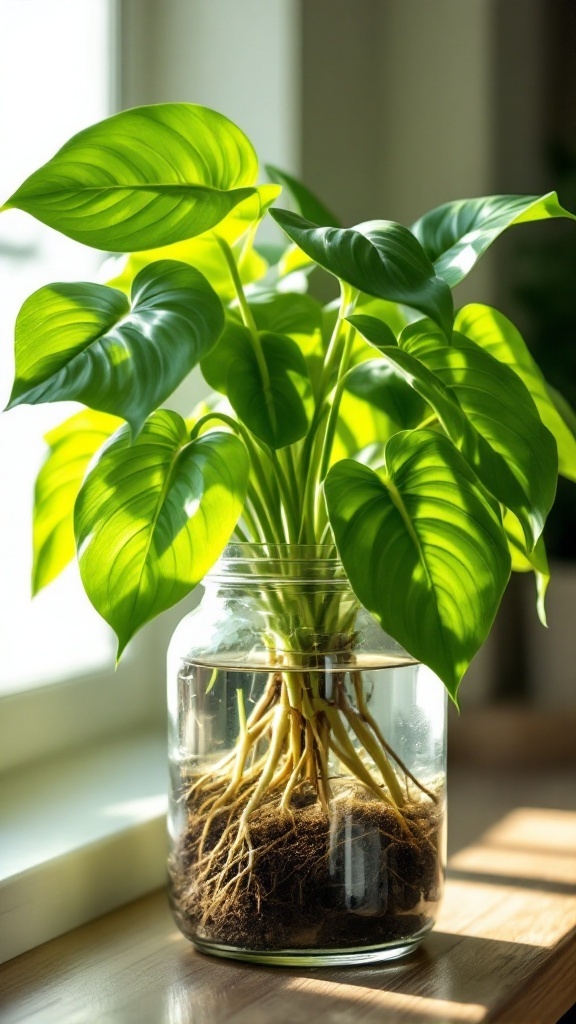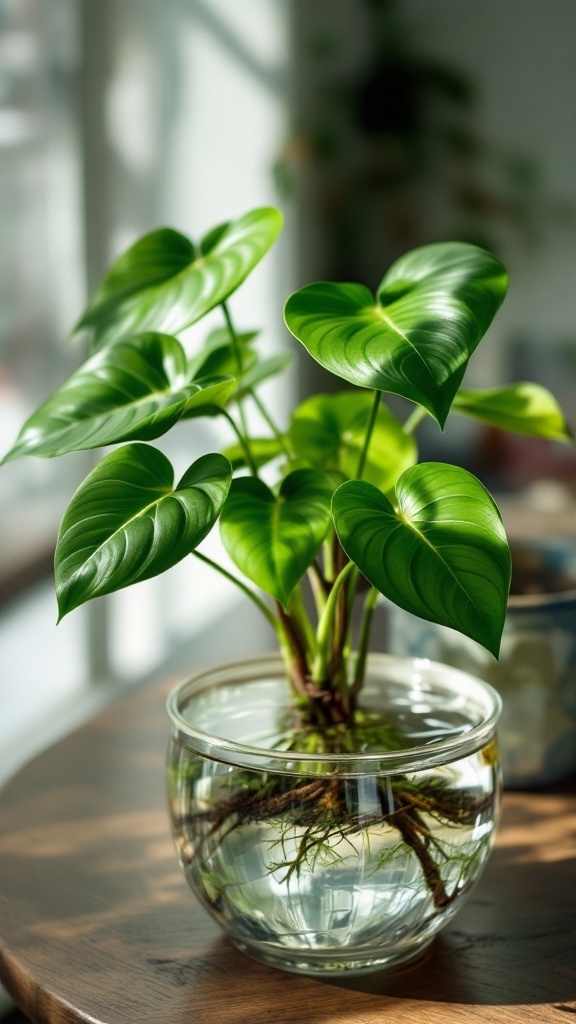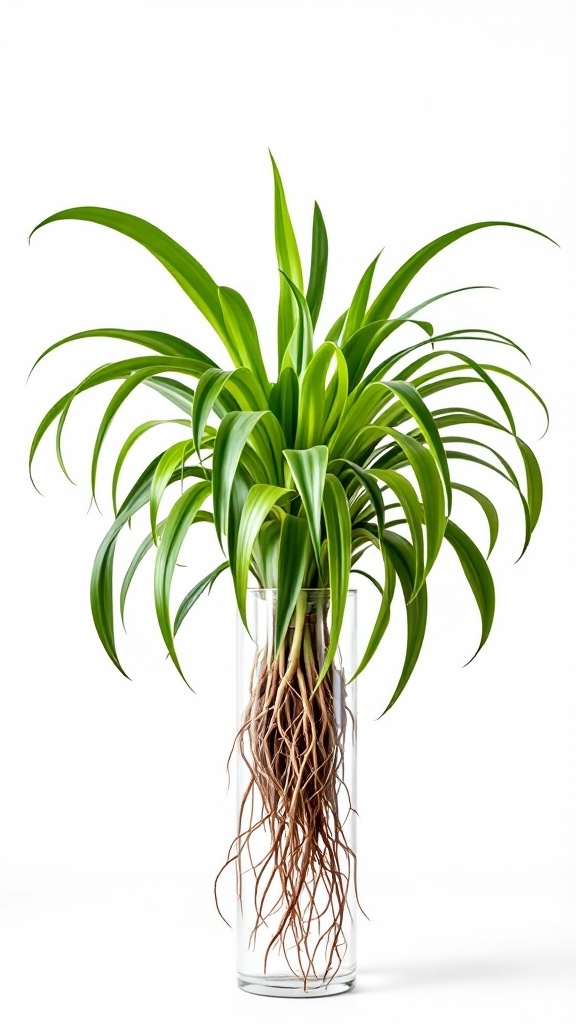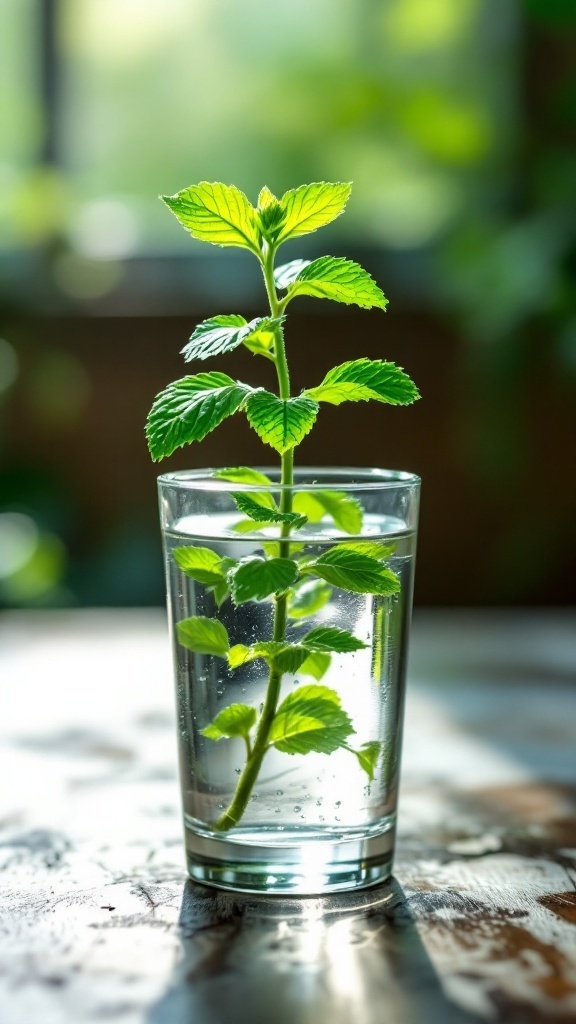If you’re looking to bring some greenery into your home without the fuss of soil, growing indoor plants in water is the way to go!
In this guide, we’ll check out nine fantastic plants that thrive in water, offering tips on how to implement and maintain them for a thriving indoor garden.
From simple cuttings to visually stunning displays, get ready to add a splash of nature to your space.
9 Amazing Indoor Plants That Thrive in Water Listed Below
1. Bamboo: Symbol of Luck and Prosperity

Bamboo is a fantastic choice if you’re looking for indoor plants that grow in water.
Its tall, elegant stalks not only add a touch of green to your space but also bring a sense of calm and tranquility.
Placing bamboo in a clear vase with pebbles makes an attractive centerpiece that can brighten any room.
This plant is often associated with luck and prosperity, making it a popular gift.
Many believe that having bamboo in your home attracts positive energy. It’s not just beautiful; it’s a symbol of good fortune!
Taking care of bamboo is simple.
Make sure it sits in fresh water, and change the water every week to keep it clean. You can also add a little liquid fertilizer every month to promote growth.
Ensure it receives indirect sunlight; too much direct sun can scorch the leaves. With these easy tips, your bamboo will thrive!
2. Pothos: The Resilient Green Companion

Pothos plants are a top pick for anyone looking for indoor plants that grow in water.
They’re known for their lush, heart-shaped leaves that can truly brighten up any space.
The image showcases a vibrant Pothos plant thriving in a glass jar filled with water, revealing its robust roots nestled in the soil beneath.
This setup not only looks great but also highlights how easy it is to grow these beauties indoors.
One of the best things about Pothos is their resilience.
They can tolerate a range of light conditions, from bright indirect light to low light.
This makes them perfect for various spots in your home.
If you want a low-maintenance plant that still adds a touch of nature to your decor, Pothos is a fantastic choice.
When it comes to maintenance, remember to change the water regularly to keep it fresh and clear.
This helps prevent any algae growth and keeps your plant healthy.
Adding a bit of liquid fertilizer every month can also support growth and vibrancy.
If you notice the leaves starting to yellow, it might be a sign that your Pothos needs a little more light or you need to change the water.
Pothos not only grow well in water but can also adapt to soil if you decide to switch things up.
Just be mindful of the transition and ensure the soil is well-draining.
Whether you choose to keep them in water or soil, Pothos will thrive and make a lovely addition to your collection of the 9 best indoor plants that grow in water.
3. Philodendron: Elegant Heart-Shaped Leaves

The Philodendron is a stunning plant known for its heart-shaped leaves, making it a favorite in many homes.
Its lush green foliage adds a touch of nature to any indoor space.
Growing this plant in water is easy and rewarding, giving you a beautiful display without the fuss of soil.
In the image, you can see a healthy Philodendron thriving in a glass bowl filled with water.
The roots are clearly visible, showcasing how well this plant adapts to a water-only environment.
The sunlight filtering through the leaves enhances the vibrant color, making it a perfect centerpiece.
For those looking to incorporate the Philodendron into their indoor plant collection, it’s important to keep a few maintenance tips in mind.
Change the water every couple of weeks to keep it fresh and oxygenated.
Make sure the water level covers the roots but doesn’t submerge the leaves.
Place it in a spot where it can receive indirect sunlight, as this plant prefers bright but filtered light.
The Philodendron is one of the top choices when considering the 9 Best Indoor Plants That Grow in Water, combining style with an easy care routine.
4. Lucky Bamboo: A Touch of Zen

Lucky bamboo is a wonderful addition to any home. It brings a sense of calmness and is often associated with good fortune.
In the image, you can see lush green stalks rising gracefully above smooth stones. This serene setup not only enhances your space but also promotes positive energy.
One of the best things about lucky bamboo is that it thrives in water.
To grow it, simply place the stems in a container filled with clean water.
Make sure to change the water every two weeks to keep it fresh and clear.
You can also add a few pebbles for stability and added charm.
Lighting is key for this plant.
Place it in a spot with indirect sunlight. Too much direct sun can scorch the leaves, while too little light may stunt growth.
Lucky bamboo prefers warmth, so keep it away from cold drafts.
For those who want to maintain this lovely plant, remember to trim any yellowing leaves.
This keeps your bamboo healthy and looking its best.
With just a little care, you’ll enjoy the beauty of lucky bamboo in your home for a long time.
5. Spider Plant: Air-Purifying Wonder

The spider plant is a fantastic choice for those looking to add greenery to their space without much fuss.
Its long, arching leaves create a beautiful display, making it a popular option for homes and offices.
You can easily grow this beauty in water, showcasing its roots in a stylish glass container.
One of the best features of the spider plant is its ability to purify the air.
It filters out harmful toxins and improves indoor air quality, making it a great addition to any indoor plants that grow in water collection.
For easy implementation, start with a healthy spider plant cutting.
Place it in a container with enough water to cover the roots but not the leaves.
Change the water every couple of weeks to keep it fresh.
This way, your plant stays healthy and vibrant.
In terms of maintenance, ensure it receives indirect sunlight. If the leaves start to yellow, it might be getting too much light.
Regularly check for signs of rot at the roots, and trim any unhealthy sections.
With just a little care, your spider plant will thrive and add a lovely touch to your indoor space!
6. Snake Plant: Hardy and Low Maintenance

The Snake Plant, known for its tall, striking leaves, is a great pick for anyone looking for indoor plants that grow in water.
This plant stands out with its lush green leaves that add a touch of vibrancy to any space.
Its hardy nature makes it incredibly easy to care for, making it a favorite among plant lovers.
When it comes to maintenance, the Snake Plant is very forgiving.
You can grow it in water by simply placing cuttings in a jar with water. Change the water every couple of weeks to keep things fresh.
Make sure the roots are submerged while keeping the leaves above the water line.
For the best results, place your Snake Plant in a spot with indirect sunlight.
It can tolerate low light, but brighter areas will encourage better growth.
If you notice the leaves getting too tall or floppy, it’s time to trim them back for a bushier appearance.
Remember, Snake Plants are also known for their air-purifying qualities, which makes them perfect for your living room or bedroom.
With just a bit of care, they can thrive beautifully in your home.
7.Mint: Fragrant and Refreshing

Mint is not just a lovely plant; it brings a delightful fragrance to your home.
Its vibrant green leaves look fantastic in water, making it one of the top Indoor Plants That Grow in Water.
To grow mint in water, simply snip off a stem with a few leaves and place it in a glass of water.
Make sure the bottom of the stem is submerged, while the leaves stay above the water.
This method encourages root growth and allows you to enjoy fresh mint easily.
For maintenance, change the water every week to keep it fresh and prevent any bacteria buildup.
Keep the glass in a spot that gets bright, indirect sunlight. Mint loves light, but too much direct sun can scorch its leaves.
With proper care, your mint plant can thrive in water for a long time.
Not only will it look great, but you’ll also have fresh mint on hand for teas, cocktails, or garnishes!
8. Coleus: Colorful Foliage in Water

Coleus plants are a fantastic choice for anyone looking to add a splash of color indoors.
With their vibrant leaves, they truly brighten up a room.
This particular plant, in a clear vase, showcases its beautiful red and yellow foliage, making it a stunning focal point.
Growing Coleus in water is simple and rewarding. Just place the cuttings in a water-filled container, ensuring the lower leaves are submerged while the top leaves stay above the water.
Change the water every week to keep it fresh and clear.
This will help the roots to grow strong and healthy.
When caring for your Coleus, place it in a spot with indirect sunlight.
Too much direct sunlight can scorch the leaves, while too little light can cause them to lose their vibrant colors.
Additionally, keep an eye on the water level, and refill it as needed.
Maintaining your Coleus is easy.
Trim the roots if they become too long and change the water regularly to prevent any bacteria build-up.
With a little attention, your Coleus can thrive beautifully in water as one of the best indoor plants that grow in water.
9. Geranium: Cheerful Blooms from Cuttings

Geraniums are a fantastic choice when looking for indoor plants that grow in water.
Their bright colors bring life to any space, making them a favorite among plant lovers.
This image shows a vibrant pot of geraniums, showcasing their cheerful blooms that can instantly uplift your mood.
Starting geraniums from cuttings is simple and rewarding.
Take healthy cuttings of about 4-6 inches long with a few leaves attached.
Place them in a jar of water, ensuring the leaves stay above the waterline.
In a few weeks, you’ll see roots develop, and that’s when you can transfer them to soil or continue growing them in water.
To keep your geraniums thriving, make sure they get plenty of bright, indirect sunlight.
Change the water regularly to prevent stagnation and root rot.
Fertilizing every few weeks can also help boost their growth.
Remember, geraniums prefer a warmer environment, so avoid placing them in cold drafts.




